Examsrevision
On this page, you find all documents, package deals, and flashcards offered by seller ExamsRevision.
- 1077
- 0
- 127
Community
- Followers
- Following
22 Reviews received
1204 items
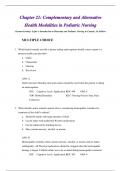
TEST BANK FOR LEIFER'S INTRODUCTION TO MATERNITY AND PEDIATRIC NURSING IN CANADA 1ST EDITION BY LEIFER |CHAPTERS 21-25|
Chapter 21: Complementary and Alternative Health Modalities in Pediatric Nursing Chapter 22: Chronic Conditions and Palliative Care: Caring for the Child and Family Chapter 23: The Child with an Eye, Ear, or Neurological Condition Chapter 24: The Child with a Musculoskeletal Condition Chapter 25: The Child with a Respiratory Condition
- Package deal
- • 5 items •
- Chapter 21: Complementary and Alternative Health Modalities in Pediatric Nursing • Exam (elaborations)
- Chapter 23: The Child with an Eye, Ear, or Neurological Condition • Exam (elaborations)
- Chapter 24: The Child with a Musculoskeletal Condition • Exam (elaborations)
- Chapter 22: Chronic Conditions and Palliative Care: Caring for the Child and Family • Exam (elaborations)
- Chapter 25: The Child with a Respiratory Condition • Exam (elaborations)
Chapter 21: Complementary and Alternative Health Modalities in Pediatric Nursing Chapter 22: Chronic Conditions and Palliative Care: Caring for the Child and Family Chapter 23: The Child with an Eye, Ear, or Neurological Condition Chapter 24: The Child with a Musculoskeletal Condition Chapter 25: The Child with a Respiratory Condition
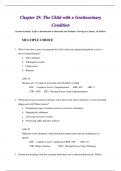
Chapter 29: The Child with a Genitourinary Condition
MULTIPLE CHOICE 1. What foods does a nurse recommend the child with acute glomerulonephritis avoid, to prevent hyperkalemia? a. Dairy products b. Wholegrain cereals c. Organ meats d. Bananas ANS: D Bananas are very high in potassium and should be avoided. DIF: Cognitive Level: Comprehension REF: 697 OBJ: 9 TOP: AGN KEY: Nursing Process Step: Implementation 2. Which physical assessment technique will a nurse omit when caring for a 2-year-old child diagnosed with Wilm...
- Package deal
- Exam (elaborations)
- • 13 pages •
MULTIPLE CHOICE 1. What foods does a nurse recommend the child with acute glomerulonephritis avoid, to prevent hyperkalemia? a. Dairy products b. Wholegrain cereals c. Organ meats d. Bananas ANS: D Bananas are very high in potassium and should be avoided. DIF: Cognitive Level: Comprehension REF: 697 OBJ: 9 TOP: AGN KEY: Nursing Process Step: Implementation 2. Which physical assessment technique will a nurse omit when caring for a 2-year-old child diagnosed with Wilm...

Chapter 25: The Child with a Respiratory Condition
MULTIPLE CHOICE 1. Which statement indicates that the child’s parents understand how to perform respiratory therapy for a child with cystic fibrosis? a. “We do her postural drainage before the aerosol therapy.” b. “We give her respiratory treatments when she is coughing a lot.” c. “We give the aerosol followed by postural drainage before meals.” d. “She needs respiratory therapy every day when she has an infection.” ANS: C Postural drainage for the child with ...
- Package deal
- Exam (elaborations)
- • 14 pages •
MULTIPLE CHOICE 1. Which statement indicates that the child’s parents understand how to perform respiratory therapy for a child with cystic fibrosis? a. “We do her postural drainage before the aerosol therapy.” b. “We give her respiratory treatments when she is coughing a lot.” c. “We give the aerosol followed by postural drainage before meals.” d. “She needs respiratory therapy every day when she has an infection.” ANS: C Postural drainage for the child with ...
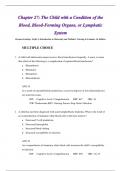
Chapter 27: The Child with a Condition of the Blood, Blood-Forming Organs, or Lymphatic System
MULTIPLE CHOICE 1. A child with thalassemia major receives blood transfusions frequently. A nurse is aware that which of the following is a complication of repeated blood transfusions? a. Hemarthrosis b. Hematuria c. Hemoptysis d. Hemosiderosis ANS: D As a result of repeated blood transfusions, excessive deposits of iron (hemosiderosis) are stored in tissues. DIF: Cognitive Level: Comprehension REF: 647 OBJ: 16 TOP: Thalassemia KEY: Nursing Process Step: Data Collection...
- Package deal
- Exam (elaborations)
- • 12 pages •
MULTIPLE CHOICE 1. A child with thalassemia major receives blood transfusions frequently. A nurse is aware that which of the following is a complication of repeated blood transfusions? a. Hemarthrosis b. Hematuria c. Hemoptysis d. Hemosiderosis ANS: D As a result of repeated blood transfusions, excessive deposits of iron (hemosiderosis) are stored in tissues. DIF: Cognitive Level: Comprehension REF: 647 OBJ: 16 TOP: Thalassemia KEY: Nursing Process Step: Data Collection...
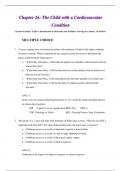
Chapter 26: The Child with a Cardiovascular Condition
MULTIPLE CHOICE 1. A nurse explains how to position an infant with tetralogy of Fallot if the infant suddenly becomes cyanotic. Which statement by the caregiver leads the nurse to determine the parent understood the instructions? a. “If the baby turns blue, I will hold him against my shoulder with his knees bent up toward his chest.” b. “If the baby turns blue, I will lay him down on a firm surface with his head lower than the rest of his body.” c. “If the baby turns blue, I ...
- Package deal
- Exam (elaborations)
- • 13 pages •
MULTIPLE CHOICE 1. A nurse explains how to position an infant with tetralogy of Fallot if the infant suddenly becomes cyanotic. Which statement by the caregiver leads the nurse to determine the parent understood the instructions? a. “If the baby turns blue, I will hold him against my shoulder with his knees bent up toward his chest.” b. “If the baby turns blue, I will lay him down on a firm surface with his head lower than the rest of his body.” c. “If the baby turns blue, I ...
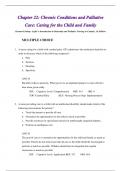
Chapter 22: Chronic Conditions and Palliative Care: Caring for the Child and Family
MULTIPLE CHOICE 1. A nurse caring for a child with cerebral palsy (CP) administers the medication baclofen in order to decrease which of the following symptoms? a. Pain b. Seizures c. Drooling d. Spasticity ANS: D Baclofen reduces spasticity. When given via an implanted pump it is more effective then when given orally. DIF: Cognitive Level: Comprehension REF: 514 OBJ: 9 TOP: Cerebral Palsy KEY: Nursing Process Step: Implementation 2. A nurse providing care to a ch...
- Package deal
- Exam (elaborations)
- • 11 pages •
MULTIPLE CHOICE 1. A nurse caring for a child with cerebral palsy (CP) administers the medication baclofen in order to decrease which of the following symptoms? a. Pain b. Seizures c. Drooling d. Spasticity ANS: D Baclofen reduces spasticity. When given via an implanted pump it is more effective then when given orally. DIF: Cognitive Level: Comprehension REF: 514 OBJ: 9 TOP: Cerebral Palsy KEY: Nursing Process Step: Implementation 2. A nurse providing care to a ch...

Chapter 24: The Child with a Musculoskeletal Condition
MULTIPLE CHOICE 1. What finding would a nurse assessing the neurovascular status of a child in Russell traction report immediately? a. Skin that is warm to the touch b. Capillary refill less than 3 seconds c. Ability to wiggle toes d. Bluish colouration of skin ANS: D Cyanosis or pallor noted in an extremity is an indication of circulatory impairment. DIF: Cognitive Level: Application REF: 568 OBJ: 7 | 8 TOP: Neurovascular Assessment KEY: Nursing Process Step: ...
- Package deal
- Exam (elaborations)
- • 15 pages •
MULTIPLE CHOICE 1. What finding would a nurse assessing the neurovascular status of a child in Russell traction report immediately? a. Skin that is warm to the touch b. Capillary refill less than 3 seconds c. Ability to wiggle toes d. Bluish colouration of skin ANS: D Cyanosis or pallor noted in an extremity is an indication of circulatory impairment. DIF: Cognitive Level: Application REF: 568 OBJ: 7 | 8 TOP: Neurovascular Assessment KEY: Nursing Process Step: ...
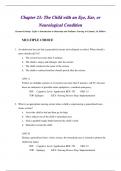
Chapter 23: The Child with an Eye, Ear, or Neurological Condition
MULTIPLE CHOICE 1. An adolescent has just had a generalized seizure and collapsed at school. When should a nurse should call 911? a. The seizure lasts more than 5 minutes. b. The child is sleepy and lethargic after the seizure. c. The child vomited at the onset of the seizure. d. The child is confused and has slurred speech after the seizure. ANS: A If there are multiple seizures or if seizures last more than 5 minutes, call 911 because these are indicators of possible status e...
- Package deal
- Exam (elaborations)
- • 14 pages •
MULTIPLE CHOICE 1. An adolescent has just had a generalized seizure and collapsed at school. When should a nurse should call 911? a. The seizure lasts more than 5 minutes. b. The child is sleepy and lethargic after the seizure. c. The child vomited at the onset of the seizure. d. The child is confused and has slurred speech after the seizure. ANS: A If there are multiple seizures or if seizures last more than 5 minutes, call 911 because these are indicators of possible status e...
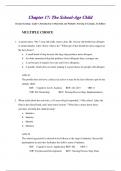
TEST BANK FOR LEIFER'S INTRODUCTION TO MATERNITY AND PEDIATRIC NURSING IN CANADA 1ST EDITION BY LEIFER |CHAPTERS 16-20|
Chapter 16: The Preschool Child Chapter 17: The School-Age Child Chapter 18: The Adolescent Chapter 19: The Child’s Experience of Hospitalization Chapter 20: Health Care Adaptations for the Child and Family
- Package deal
- • 5 items •
- Chapter 17: The School-Age Child • Exam (elaborations)
- Chapter 18: The Adolescent • Exam (elaborations)
- Chapter 16: The Preschool Child • Exam (elaborations)
- Chapter 20: Health Care Adaptations for the Child and Family • Exam (elaborations)
- Chapter 19: The Child’s Experience of Hospitalization • Exam (elaborations)
Chapter 16: The Preschool Child Chapter 17: The School-Age Child Chapter 18: The Adolescent Chapter 19: The Child’s Experience of Hospitalization Chapter 20: Health Care Adaptations for the Child and Family
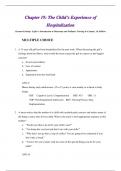
Chapter 19: The Child’s Experience of Hospitalization
MULTIPLE CHOICE 1. A 13-year-old girl has been hospitalized for the past week. When discussing the girl’s feelings about her illness, what would the nurse expect the girl to express as her biggest concern? a. Invasive procedures b. Loss of control c. Appearance d. Separation from her boyfriend ANS: C Illness during early adolescence (12 to 15 years) is seen mainly as a threat to body image. DIF: Cognitive Level: Comprehension REF: 453 OBJ: 11 TOP: The Hospitalized Adol...
- Package deal
- Exam (elaborations)
- • 16 pages •
MULTIPLE CHOICE 1. A 13-year-old girl has been hospitalized for the past week. When discussing the girl’s feelings about her illness, what would the nurse expect the girl to express as her biggest concern? a. Invasive procedures b. Loss of control c. Appearance d. Separation from her boyfriend ANS: C Illness during early adolescence (12 to 15 years) is seen mainly as a threat to body image. DIF: Cognitive Level: Comprehension REF: 453 OBJ: 11 TOP: The Hospitalized Adol...

TEST BANK PUBLIC HEALTH NURSING: POPULATION-CENTERED HEALTH CARE IN THE COMMUNITY, 10TH EDITION BY STANHOPE
Chapter 28: Care of Patients with Disorders of the Upper Gastrointestinal System |deWit: Medical-Surgical Nursing: Concepts & Practice, 3rd Edition
Chapter 48: Immunostimulants and Immunomodulators Introductory Clinical Pharmacology 12th Edition by Susan M Ford
Chapter 47: Vaccines Introductory Clinical Pharmacology 12th Edition by Susan M Ford
Chapter 43: Male and Female Hormones Introductory Clinical Pharmacology 12th Edition by Susan M Ford